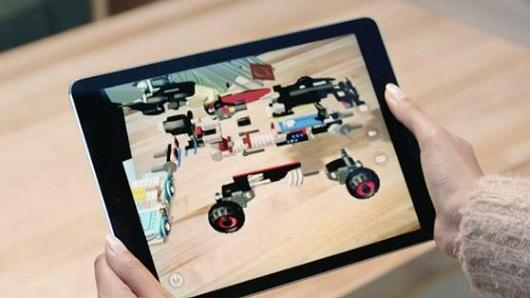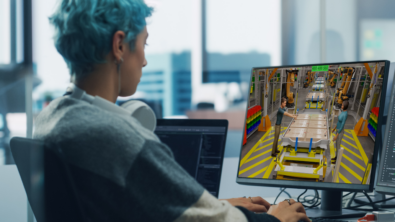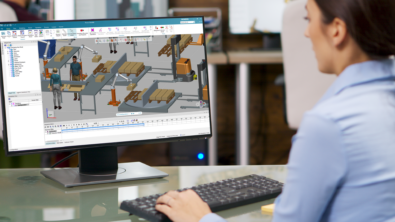Virtual factories of the future

Virtual factories of the future: Augmented and virtual reality systems in manufacturing
By Ian Fisher, CTO Architecture & Innovation, Digital Factory Division, Siemens PLM Software
As the physical and digital worlds converge, manufacturers are looking for new ways to view and understand their operations, how equipment can be serviced, and even how information is consumed. This blog will focus on how augmented reality (AR) and virtual reality (VR) systems can help achieve these objectives.
I will describe the state of augmented and virtual reality systems today and how they are evolving; how and where manufacturers are applying the technology; the benefits and challenges of adopting and using the technology effectively, and guidelines for implementation and adoption.
Overview
As designers, engineers, manufacturers and business leaders we have access to greater amounts of information than ever before, but we’re not getting full value from it. The problem is we’ve come to accept that we must create and interact with data / information by working with a flat two-dimensional screen – by either sitting in front of a computer or holding a mobile device. And when we work this way, we’re not always interacting with the information where and when we need it most and we’re restricting the use of our hands. This limits productivity and competitiveness.
We need to break through the barrier and find better ways to use and interact with our digital information. Augmented Reality / Virtual Reality (AR/VR) gives us super powers to reimagine what is humanly possible and transform how we conduct business.
AR /VR offers big opportunities for business. These technologies do not change what you do, but they will change how you do things. According to the Gartner Hype Cycle, AR has the most potential to disrupt conventional processes but also has most open technical challenges to address and is being heavily driven by autonomous vehicle initiatives.
 Gartner Hype CycleVR has matured relatively recently. It is being used in mainstream business operations is more mature that AR, and it is being heavily driven by the gaming industry.
Gartner Hype CycleVR has matured relatively recently. It is being used in mainstream business operations is more mature that AR, and it is being heavily driven by the gaming industry.
Now is a good time to start looking into AR/VR because of cost and availability, CPU/GPU/RAM, Computervision technology, and data/analytics.Let me explain.
Cost & Availability
- Competition in the gaming industry has driven down the cost and raised availability of the devices
- HTC Vive, Oculus Rift, HoloLens, DAQRI, Tablets/phone with high quality cameras.
- Imaging, motion sensing and geo-awareness of devices is almost universal
- VR: $100,000 for CAVE + Real Estate versus $1,000 for Vive + cubicle
- VR cost is dropping quickly
- AR cost is higher as it is still being heavily invested in
CPU/GPU/RAM
- Cost and size of compute (in device and cloud) improving – there is no such thing as a disconnected or compute challenged device
- Power storage methods and low power compute are making mobile and wearable AR/VR a reality
Computervision technology
- Scanning and recognition algorithms rapidly improving – driven from automotive, consumer and industry
Data/Analytics
- Cost and wealth of cloud-based analytics and network driving real-time data into operational activities
Where can augmented reality be used?
Augmented Reality is primarily used where virtual elements need to be integrated into an existing real world environment.
For example:
For training to increase speed to knowledge, efficiency, confidence, and error reduction
- In scene guidance, no instructor required
- Hands-free access to reference information
- More intuitive learning
For guided and validated work instructions to increase productivity and quality
- Hands-free documentation
- In scene guidance of assembly
- Validation of completed tasks
For manufacturing plant and factory monitoring to produce effective monitoring and management
- In-scene instrumentation and status
- Throughput statistics
For guided field servicing as a knowledge multiplier
- Remote servicing with hands-free in-scene guidance
- Recording of issues and snags
Where can virtual reality be used?
VR is primarily used with a virtual product in a virtual environment. For example:
For design reviews and studies to improve productivity and accuracy
- 1:1 or any scale investigation of design
- Complex 3D environment – packaging and routing
- Ergonomic and serviceability studies
For training to increase effectiveness and safety
- Scaled experience for process and procedures
- For expensive (remote, unique, non-existent) and dangerous environments
For sales configurators to improve effectiveness, fit for purpose
- Highlight customizable products, ETO types of situations
- Configure and build up the virtual product – let users/customers experience the product for styling, fit for purpose, ergonomics
Best Practices for starting
General best practices that apply to both AR/VR:
- Start with small pilots.
- Target small/simple use cases with one or two simple KPIs
- Don’t get too complicated too soon
- Cheaper/smaller the better
- Avoid large equipment outlays
- Technology is changing rapidly, expect rapid change
- Understand impact on infrastructure
- Networks
- IT support
- Additional H/W costs
- Understand impact on business process
- What will need to change to best support an AR/VR approach
- People training/tribal knowledge
VR
- Get people familiar with the technology in a pilot
- Start laying the technical infrastructure groundwork
- Consider the cost of VR –versus- Caves
- Look at using now for design reviews / sales configurators (especially if you’re already using 3D modeling / viewing applications)
- Put real data in the environment
- Solve some real problems (however small)
- Make it easy for people to try/experiment
- Help people over the ‘it’s just a game’ perception
- Companies put VR rooms on the way to the cafeteria to get the rest of the company familiar with the technology

AR
- Look at piloting for training
- Look at piloting for servicing / work instructions (especially if you already have a strong digital system to connect to)
- Improves productivity / traceability, especially when the production system is highly flexible
- Can eliminate manual data entry, record issues / faults (voice activation is good, takes pictures, video)
- Hands-free aspect in helpful on shop floor
- Look at piloting for remote expert support / knowledge multiplier use case
- One company in Think Tank now taking this into production
- Statement: “Over the past 2 months, the progress has already paid for itself.”
- Measures: avoiding travel cost and speed of response
- User acceptance is critical
- Central group saw immediate value
- Remote site user acceptance was a challenge – needed to clearly understand the value and have skin in the game
- Training is important (what it can do, what it can’t)
- Device selection is important for successful POC
- Be mindful of device battery life
- Be mindful of device weight (heavy items difficult to use for extended periods)

Where do I go from here?Here is a list of things to think about
Define your AR/VR strategy. Do you have a strategy to go paperless?
- Do you have a strategy to connect a digital thread to the shop floor?
- Do you have a strategy to put a force multiplier on our experts?
- Start a pilot / proof of concept, keep it simply and start small.
- Be mindful of culture, infrastructure, technology and people. Define value proposition.
- Have clear performance indicators / measures in mind and focus on productivity.
- Evaluate and decide on device and software.
- Focus on getting the user experience correct (understand what the use is doing).
- Work with a technology partner.
- Invest cautiously in equipment. There’s a hardware and technical revolution going on.
Don’t wait to define your strategy and start your AR/VR pilot!
Check out this video to learn about the breakthrough strengths of a smart factory which include, among other things, augmented reality and virtual reality.
If you enjoyed reading this blog, please comment or leave a “kudos” below.

